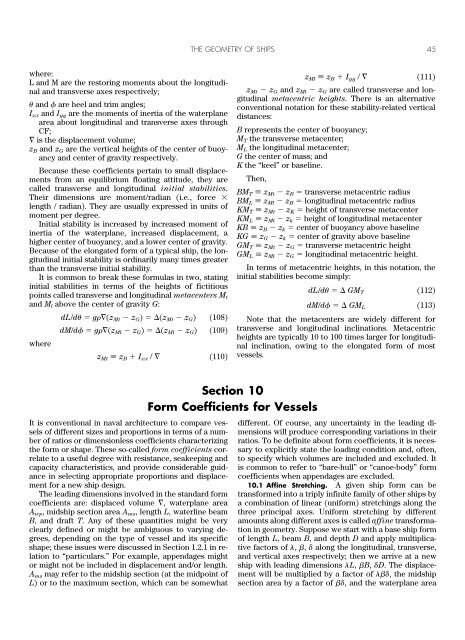The Geometry of Ships
You also want an ePaper? Increase the reach of your titles
YUMPU automatically turns print PDFs into web optimized ePapers that Google loves.
44 THE PRINCIPLES OF NAVAL ARCHITECTURE SERIES<br />
Fig. 35 Illustration <strong>of</strong> various types <strong>of</strong> equilibrium. (a) Unconditionally<br />
stable. (b) Unconditionally unstable. (c) Neutral. (d) Conditionally stable,<br />
globally unstable.<br />
<strong>The</strong> same ball resting at a maximum <strong>of</strong> a convex surface<br />
is a typical unstable equilibrium. Following a small<br />
displacement in any direction, the ball tends to accelerate<br />
away from its initial position. In an unstable system,<br />
a small disturbance produces a large result.<br />
On the boundary between stable and unstable behavior,<br />
there is neutral stability, represented by a ball on a<br />
level plane. Here, there is no tendency either to return to<br />
an initial equilibrium, or to accelerate away from it.<br />
Stability can depend on the nature <strong>of</strong> the disturbance.<br />
Picture the ball resting at the saddle point on a saddleshaped<br />
surface. In this situation, the system is stable<br />
with respect to disturbances in one direction and simultaneously<br />
unstable with respect to disturbances in other<br />
directions. A ship can be stable with respect to a change<br />
<strong>of</strong> pitch and unstable with respect to a change in roll, or<br />
(less likely) vice versa. In order to be globally stable, the<br />
system must be stable with respect to all possible “directions”<br />
<strong>of</strong> disturbance, or degrees <strong>of</strong> freedom.<br />
A 3-D rigid body has in general six degrees <strong>of</strong> freedom:<br />
linear displacement along three axes and rotations<br />
with respect to three axes. Let us first examine hydrostatic<br />
stability with respect to linear displacements.<br />
When a floating body is displaced horizontally, there is<br />
no restoring force arising from hydrostatics. This results<br />
in neutral stability for these two degrees <strong>of</strong> freedom.<br />
Likewise, rotation about a vertical axis results in no<br />
change in volume or restoring moment, so is a neutrally<br />
stable degree <strong>of</strong> freedom.<br />
<strong>The</strong> vertical direction is more interesting. In the case<br />
<strong>of</strong> a fully submerged neutrally buoyant rigid body, the<br />
equilibrium is neutral; a small displacement in z does<br />
not change the vertical (buoyant) force, since the volume<br />
is constant. (Note, however, that a submerged<br />
compressible body will always be unstable with respect<br />
to vertical displacement. If the disturbance is a slight<br />
downward displacement, the increased pressure induces<br />
a decrease in volume; this reduces the buoyant<br />
force, so the body tends to sink. Conversely, if the disturbance<br />
is a slight upward displacement, the body expands,<br />
displacing more fluid, so it tends to rise toward<br />
the surface.)<br />
A rigid body floating in equilibrium with positive waterplane<br />
area A wp is always stable with respect to vertical<br />
displacement. If the disturbance is a small positive<br />
(upward) displacement in z, say dz, the displaced volume<br />
decreases (by A wp dz), decreasing buoyancy relative<br />
to the fixed weight, so the imbalance <strong>of</strong> forces will<br />
tend to return the body to its equilibrium flotation. gA wp<br />
is the coefficient <strong>of</strong> stiffness with respect to the vertical<br />
degree <strong>of</strong> freedom: the hydrostatic restoring force per<br />
unit <strong>of</strong> displacement distance, exactly like a “spring constant”<br />
in mechanics.<br />
<strong>The</strong> two remaining degrees <strong>of</strong> freedom are rotations<br />
about horizontal axes; for example, for a ship, trim (rotation<br />
about a transverse axis) and heel (rotation about<br />
a longitudinal axis). For a fully submerged rigid body,<br />
the stability <strong>of</strong> these degrees <strong>of</strong> freedom depends entirely<br />
on the vertical position <strong>of</strong> the center <strong>of</strong> gravity<br />
(CG) with respect to the center <strong>of</strong> buoyancy (CB).<br />
Archimedes’ principle states that equilibrium requires<br />
that the center <strong>of</strong> gravity and the center <strong>of</strong> buoyancy lie<br />
on the same vertical line. If the two centers are coincident,<br />
the submerged body can assume any attitude, with<br />
neutral stability. If they are distinct, there will be exactly<br />
one attitude <strong>of</strong> stable equilibrium, with the CG below the<br />
CB, and exactly one attitude <strong>of</strong> unstable equilibrium<br />
with the CG above the CB.<br />
For floating bodies, the rotations about horizontal<br />
axes are generally very important, and hydrostatically interesting,<br />
degrees <strong>of</strong> freedom. <strong>The</strong> question is, will the<br />
vessel return to an upright attitude following a small<br />
displacement in heel or trim? And, how strong is her tendency<br />
to do so? In Moore (2009), it is shown that the centroid<br />
<strong>of</strong> waterplane area, also known as the center <strong>of</strong><br />
flotation (CF), is a pivot point about which small rotations<br />
can take place with zero change <strong>of</strong> displacement;<br />
and the stability <strong>of</strong> these degrees <strong>of</strong> freedom depends on<br />
the moments <strong>of</strong> inertia <strong>of</strong> the waterplane area about<br />
axes through the CF:<br />
dL/d g[I xx (z B z G )] (106)<br />
dM/d g[I yy (z B z G )] (107)



